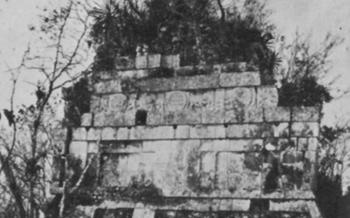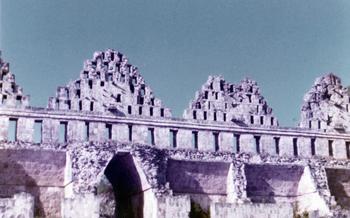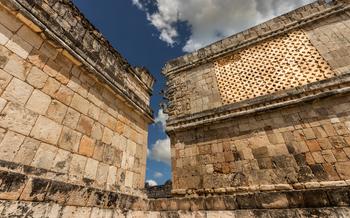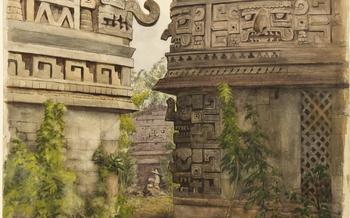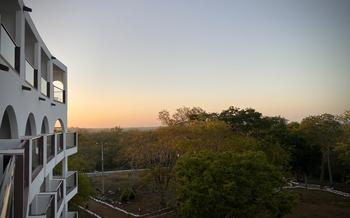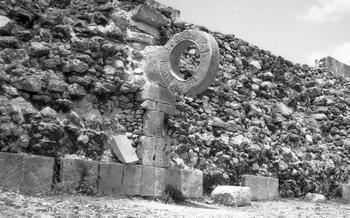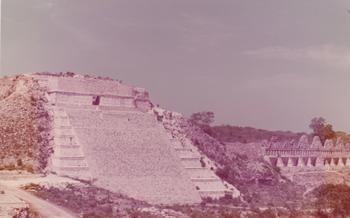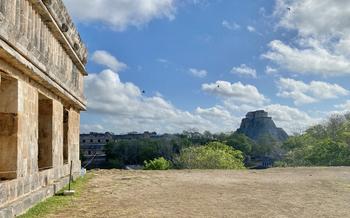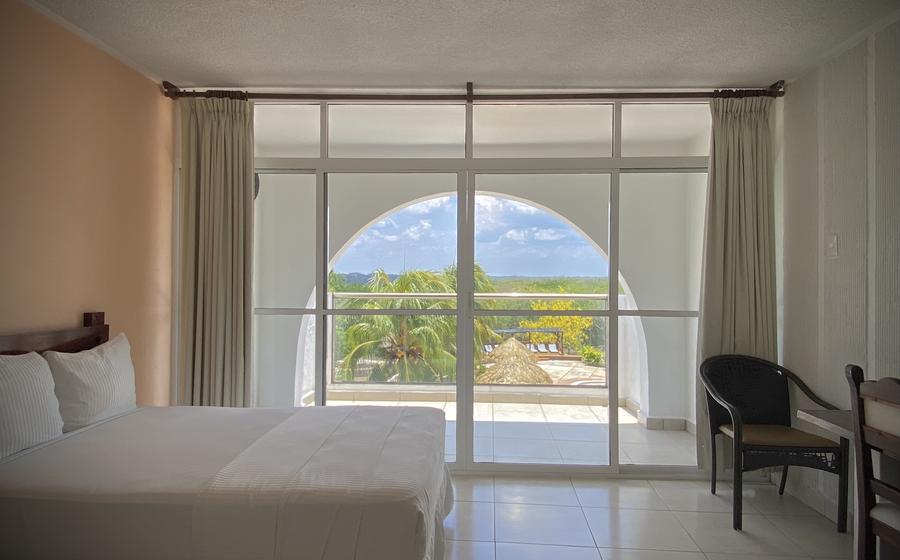
Paseo de Montejo in Merida
- Uxmal: An Ancient Mayan City in the Yucatan Peninsula
- Exploring the Ruins of Uxmal: A Journey Through Time
- The Pyramid of the Magician: A Majestic Structure of Power
- The Ball Court: A Place of Ritual and Competition
- The Nunnery Quadrangle: A Complex for Religious and Civic Life
- The Governor's Palace: A Symbol of Royal Power and Prestige
- The House of the Turtles: A Glimpse into Everyday Mayan Life
- The Great Platform: A Majestic Foundation for Ceremonies
- The Light and Sound Show: A Multisensory Journey Through Uxmal's History
- The Uxmal Museum: A Treasure Trove of Mayan Artifacts
- The Maya Train: A Convenient Way to Reach Uxmal
- Sustainable Tourism in Uxmal: Preserving the Past for the Future
- Insider Tip: Exploring Uxmal Beyond the Main Ruins
Uxmal: An Ancient Mayan City in the Yucatan Peninsula
Standing tall among the lush vegetation of the Yucatan Peninsula, Uxmal is an ancient Mayan city that captivates visitors with its well-preserved ruins, intriguing history, and unique architectural style. Once a thriving metropolis, Uxmal played a crucial role in the political and cultural landscape of the Maya civilization. Its impressive structures, intricate carvings, and symbolic motifs offer a glimpse into the lives, beliefs, and achievements of this enigmatic civilization.
As you wander through the archaeological site, you'll be struck by the city's grandeur, which earned it the nickname "Thrice-built." The Mayans believed that Uxmal was built three times, each time surpassing the previous in magnificence and splendor. Its strategic location along trade routes and its access to natural resources contributed to its rise as a prominent center of power and influence.
Uxmal's architectural style, known as Puuc, is characterized by its smooth, rounded corners, intricate stone mosaics, and elaborate roof combs. The city is home to some of the most iconic Mayan structures, including the Pyramid of the Magician, the Governor's Palace, and the Nunnery Quadrangle. Each building showcases the Mayans' advanced knowledge of mathematics, astronomy, and engineering, reflecting their deep connection to the cosmos and their reverence for the natural world.
A visit to Uxmal is not just a journey through ancient ruins but a fascinating exploration of a civilization that left an indelible mark on history. As you explore the site, you'll uncover the stories of powerful rulers, skilled artisans, and a people whose legacy continues to inspire and intrigue.
Exploring the Ruins of Uxmal: A Journey Through Time
Uxmal's archaeological site is a treasure trove of ancient Mayan structures, each with its own unique story to tell. Among the must-see buildings are the Governor's Palace, a sprawling complex that served as the administrative and residential center of the city; the Nunnery Quadrangle, a complex of interconnected buildings that housed religious and civic functions; and the Great Platform, a massive, elevated platform that supported several temples and other structures.
Uxmal's architecture is characterized by its unique Puuc style, which features intricate carvings, geometric designs, and corbelled arches. The Pyramid of the Magician, the site's tallest structure, is a prime example of this style, with its towering height, elaborate facade, and impressive interior chambers.
Beyond its architectural marvels, Uxmal is also rich in symbolism and stories. The Ball Court, for example, was not just a place for खेल, but also held deep religious and cosmological significance. The Temple of the Phalli, with its phallic-shaped carvings, is a testament to the Mayans' reverence for fertility and creation.
To fully appreciate the site's complexity and significance, it's helpful to have a guide or do some research beforehand. This will allow you to understand the symbolism and stories behind the ruins, and to navigate the site more effectively.
The Pyramid of the Magician: A Majestic Structure of Power
Of all the marvels at Uxmal, the Pyramid of the Magician stands as the most awe-inspiring. Its history is shrouded in mystery, with legends attributing its construction to a single night's work by a powerful sorcerer. The pyramid's architectural brilliance is evident in its sloping sides, intricate carvings, and a unique oval base. Climbing its steep steps, I felt a surge of excitement and reverence, culminating in the breathtaking view from the top. The surrounding jungle canopies stretched out before me, and I couldn't help but marvel at the foresight of the ancient builders who chose this strategic location. The Pyramid of the Magician is a testament to the power and ingenuity of the Maya, leaving visitors like me with a sense of wonder and respect for their legacy.
The Ball Court: A Place of Ritual and Competition
In the heart of Uxmal, the ancient ball court stands as a testament to the significance of the ball game in Mayan culture. This sacred space, meticulously designed with sloping sides and stone rings, was not merely a place of competition but a stage for rituals, symbolism, and deep cultural meaning.
The ball game, known as "Pok-ta-Pok," held a profound place in Mayan society. It was not just a sport but a ritual, a metaphor for the cosmic struggle between light and darkness, life and death. The ball, made of solid rubber and weighing several pounds, was propelled by the hips and elbows of the players, who wore protective gear and aimed to keep the ball in play without using their hands.
The architecture of the ball court reflects its ritual significance. The sloping sides provided better viewing angles for spectators, while the stone rings, placed at strategic points, served as targets for the players. The acoustics of the court were carefully designed to amplify the sound of the ball hitting the walls, creating a dramatic atmosphere.
Beyond the physical structure, the ball game was steeped in symbolism. The court itself represented the underworld, and the ball symbolized the sun. The game's outcome was believed to have real-world consequences, influencing everything from agricultural fertility to political power. The players, often representing different villages or clans, were seen as embodying the forces of nature and the cosmos.
Visiting the ball court in Uxmal is a journey into the heart of Mayan culture. It's a place where sport, ritual, and symbolism intertwined, creating a spectacle that captivated and awed the ancient Maya. As you stand in this sacred space, you can almost hear the echoes of the ancient game, feel the tension and excitement of the players, and glimpse the profound significance it held for the Maya civilization.
The Nunnery Quadrangle: A Complex for Religious and Civic Life
Amidst the grandeur of Uxmal's ruins, the Nunnery Quadrangle stands as a testament to the city's religious and civic life. While its name suggests a cloistered retreat for women, scholars believe it served a broader purpose, housing priests, scribes, and other officials who played vital roles in Mayan society.
Architectural Features and Unique Structures:
The quadrangle is a complex of buildings arranged around a central courtyard. Its most striking feature is the intricate decorations adorning its facades. Geometric designs, human figures, and hieroglyphs create a captivating visual narrative, offering glimpses into the stories and beliefs of the ancient Maya.
Symbolism and Stories:
The Nunnery Quadrangle is renowned for its symbolic reliefs and carvings. One notable feature is the "Chac Mool" figure, depicted reclining with a bowl on its abdomen. This figure, believed to represent a rain god, played a significant role in Mayan rituals and mythology.
Another highlight is the "Throne of the Jaguars," a stone seat flanked by jaguar sculptures. This throne was likely used by rulers and high-ranking officials during ceremonies and important gatherings.
Personal Impressions and Experiences:
Stepping into the Nunnery Quadrangle is like stepping back in time. The intricate carvings, the serene ambiance, and the palpable sense of history create an immersive experience. It's easy to imagine the quadrangle bustling with activity, as priests performed rituals, scribes recorded important events, and officials conducted the affairs of the city.
As you explore the quadrangle, take the time to appreciate the details and imagine the stories behind them. Each relief and carving holds clues to the beliefs, customs, and daily lives of the ancient Maya. Let the Nunnery Quadrangle transport you to a time when Uxmal flourished as a vibrant center of Mayan culture and civilization.
The Governor's Palace: A Symbol of Royal Power and Prestige
The Governor's Palace stands as a testament to the power and prestige of the ancient Mayan rulers of Uxmal. Built atop a massive platform, the palace dominates the site with its imposing presence. Its intricate facade showcases exquisitely carved reliefs depicting Mayan rulers, deities, and scenes of everyday life.
The palace consists of a series of interconnected rooms and courtyards, each serving a specific purpose. One of the most striking features is the throne room, adorned with elaborate carvings and a massive throne carved from a single block of stone. The walls are adorned with vibrant murals, providing glimpses into the lives and rituals of the Mayan elite.
The Governor's Palace offers a fascinating glimpse into the political and social hierarchy of ancient Uxmal. It was not just a residence for the ruler but also a center of government and administration. Here, the Maya conducted important ceremonies, received foreign dignitaries, and made decisions that shaped the fate of their kingdom.
As I stood within the palace, I couldn't help but feel a sense of awe and admiration for the skill and artistry of the ancient Maya. The Governor's Palace is a true masterpiece of Mayan architecture and a reminder of the grandeur and sophistication of their civilization.
The House of the Turtles: A Glimpse into Everyday Mayan Life
Purpose and Function of the House
The House of the Turtles, nestled amidst the ruins of Uxmal, holds immense cultural significance. Constructed as a residential building for the elite, it serves as a window into the daily lives of the ancient Mayans. The structure comprises a series of interconnected rooms, each with a specific function, reflecting the social hierarchy and organization of the Mayan society.
Architecture, Symbolism, and Cultural Significance
Featuring a traditional Mayan architectural style, the House of the Turtles showcases intricate carvings and symbolic motifs. The facade displays a series of turtle shells, representing fertility, abundance, and the connection to the natural world. The interior walls are adorned with bas-reliefs depicting everyday scenes, offering insights into Mayan customs, rituals, and agricultural practices.
Insights into the Daily Lives and Customs of the Ancient Mayans
Exploring the House of the Turtles is like stepping back in time, providing a glimpse into the domestic life of the ancient Mayans. The rooms served various purposes, from sleeping quarters to storage areas, and each held unique significance. Artifacts discovered within the house, such as ceramic vessels, tools, and personal items, further enhance our understanding of their daily routines and cultural practices.
Personal Reflections or Observations While Exploring the House
My visit to the House of the Turtles was a profound experience, allowing me to connect with the ancient Mayan people on a personal level. Imagining the daily activities that once took place within these walls, from family gatherings to ceremonial rituals, brought a sense of intimacy and reverence. The intricate carvings and symbolic motifs spoke volumes about the richness and complexity of their culture.
The Great Platform: A Majestic Foundation for Ceremonies
Amidst the impressive ruins of Uxmal, the Great Platform stands as a testament to the architectural prowess and ceremonial significance of the ancient Mayans. Constructed as a massive elevated base, the platform served as a foundation for various structures, including temples, palaces, and other important buildings. Its sheer size and commanding presence create an awe-inspiring sight for visitors to behold.
The platform is constructed from massive blocks of limestone, meticulously fitted together without the use of mortar. Its dimensions are staggering, measuring approximately 150 meters in length, 130 meters in width, and 12 meters in height. The surface of the platform is remarkably flat, showcasing the precision and skill of the Mayan builders.
The Great Platform was not merely a structural marvel but also a sacred space used for religious ceremonies and public gatherings. The elevated position offered a commanding view of the surrounding area, symbolizing the power and authority of the Mayan rulers. It is believed that important rituals, such as the Maya ball game or the veneration of deities, took place on the platform, making it a focal point for spiritual and civic life.
Walking along the Great Platform is an unforgettable experience. Its vast expanse and the surrounding ruins create a sense of grandeur and history. Visitors can wander through the remnants of ancient temples and palaces, imagining the bustling activity that once took place here. The platform's elevated position offers panoramic views of the Uxmal archaeological site and the surrounding countryside, providing a breathtaking backdrop for exploration.
The Light and Sound Show: A Multisensory Journey Through Uxmal's History
As the sun sets over the ancient city of Uxmal, a captivating spectacle unfolds, transporting visitors back in time through the magic of sound and light. The Light and Sound Show, a must-see attraction, brings Uxmal's rich history and cultural heritage to life, immersing visitors in a multisensory experience that is both educational and unforgettable.
The show begins with an introduction to the ancient Maya civilization, setting the stage for a journey through their remarkable achievements and contributions to Mesoamerican history. As the lights illuminate the majestic structures, the sounds of traditional Mayan music and storytelling fill the air, creating an atmosphere of awe and wonder.
The narration delves into the myths, legends, and rituals that shaped Uxmal's past, bringing to life the stories of its rulers, priests, and ordinary citizens. The play of lights and shadows dances across the facades of the buildings, highlighting intricate carvings and architectural details that speak to the artistry and ingenuity of the ancient Maya.
The show's climax is a breathtaking recreation of the ancient Maya ball game, a ritual that held deep symbolic and religious significance. The ball court comes alive with the sounds of the game, as the echoes of the ball bouncing off the walls reverberate through the night. The show concludes with a message of hope and resilience, reminding visitors of the enduring legacy of the Maya civilization and the importance of preserving their cultural heritage for future generations.
Attending the Light and Sound Show is a unique and immersive way to experience the magic of Uxmal. It is a must-do activity for anyone interested in exploring the history and culture of the ancient Maya, and a perfect way to end a day of exploration at this awe-inspiring archaeological site.
Tips for Attending the Light and Sound Show:
- Arrive early to secure a good viewing spot.
- Bring a jacket or sweater, as the evenings can be cool, especially during the winter months.
- The show is presented in Spanish, but English headsets are available for rent.
- Allow ample time to explore the archaeological site before the show, as it provides a deeper understanding of the context and significance of the performance.
- The show is suitable for visitors of all ages, but younger children may find some of the content frightening.
The Uxmal Museum: A Treasure Trove of Mayan Artifacts
Housed within a beautiful colonial-era building, the Uxmal Museum is a treasure trove of Mayan artifacts and cultural heritage. Established in 1991, the museum offers a comprehensive insight into the ancient Mayan civilization through its extensive collection of sculptures, pottery, jewelry, and other artifacts excavated from the Uxmal ruins and the surrounding region.
The museum's displays are well-curated and informative, showcasing a wide range of artifacts that provide a glimpse into the daily lives, religious beliefs, and artistic traditions of the Mayans. Visitors can admire intricate stone carvings depicting Mayan rulers and deities, beautifully painted ceramic vessels, and delicate jade ornaments that speak to the skill and artistry of these ancient craftsmen.
In addition to the main exhibits, the museum also features a section dedicated to the history of Uxmal and its restoration, as well as a temporary exhibition space that showcases rotating displays on various aspects of Mayan culture. The museum also offers guided tours in Spanish and English, providing visitors with a deeper understanding of the artifacts and the context in which they were created.
Whether you're a history buff, an art enthusiast, or simply curious about the Mayan civilization, the Uxmal Museum is a must-visit destination that offers a valuable opportunity to learn about and appreciate the rich cultural heritage of this ancient civilization.
The Maya Train: A Convenient Way to Reach Uxmal
Traveling to Uxmal has become more convenient and eco-friendly with the introduction of the Maya Train, a modern rail system designed to connect the Yucatan Peninsula's most iconic cultural and natural destinations. The train offers a comfortable and scenic journey, allowing travelers to admire the region's lush landscapes and vibrant communities.
With multiple routes and schedules, the Maya Train provides easy access to Uxmal from major cities like Cancun, Merida, and Valladolid. Fares are affordable, making it an accessible option for budget-conscious travelers. Moreover, the train's commitment to sustainability aligns with Uxmal's focus on responsible tourism.
Tip: Book your tickets in advance, especially during peak tourist season, to secure a seat and avoid long lines.
Personal Experience:
During my recent trip to Uxmal, I opted to take the Maya Train from Merida, the capital of Yucatan. The journey was smooth and enjoyable, offering breathtaking views of the countryside. Upon arrival at the Uxmal station, I was just a short walk away from the archaeological site's entrance. The convenience of the Maya Train allowed me to maximize my time exploring the ancient ruins and immersing myself in the history and culture of Uxmal.
Sustainable Tourism in Uxmal: Preserving the Past for the Future
Uxmal, like many other ancient Mayan cities, faces the challenges of preserving its cultural heritage while accommodating the influx of tourism. Sustainable tourism practices are crucial to strike a balance between showcasing this remarkable site and protecting its environment and local communities.
The archaeological site has implemented various initiatives to promote sustainability. Visitors are encouraged to use eco-friendly transportation options, such as bicycles or electric vehicles, to minimize carbon emissions. Waste management systems have been put in place to reduce pollution and ensure proper disposal. Additionally, community-based tourism projects have been established, allowing local people to benefit directly from tourism revenue and share their cultural heritage with visitors.
As a traveler, you can contribute to sustainable tourism by being mindful of your impact. Opt for guided tours that support local businesses and promote responsible practices. Respect the cultural traditions of the Maya people, and avoid touching or climbing on ancient structures. By making sustainable choices, you can help preserve Uxmal's rich legacy while ensuring future generations can enjoy this incredible site.
My personal experience with sustainable tourism in Uxmal was incredibly rewarding. I had the opportunity to participate in a community-based cooking class, where I learned about traditional Mayan cuisine and cooking techniques from local women. The proceeds from the class directly supported the community, and I felt a sense of connection and respect for the local culture. Additionally, I made an effort to minimize my plastic consumption by bringing my reusable water bottle and avoiding single-use items. By embracing sustainable practices, I felt like I was not only a visitor but also a responsible steward of this ancient city.
Insider Tip: Exploring Uxmal Beyond the Main Ruins
While the main ruins of Uxmal are undoubtedly impressive, there's so much more to discover beyond the well-trodden paths. For a truly immersive experience, venture into the less-visited corners of the archaeological site, where hidden gems and lesser-known structures await. Explore the smaller temples, such as the House of the Pigeons or the Temple of the Old Woman, each with its unique charm and history.
Step off the beaten track and wander through the surrounding countryside, where you'll find picturesque haciendas, lush forests, and tranquil cenotes. Visit the Hacienda Uxmal, a beautifully preserved 17th-century estate that offers a glimpse into the region's colonial past. Take a refreshing dip in the crystal-clear waters of Cenote Azul, a hidden gem located just a short drive from the ruins.
For a truly unique experience, consider booking a guided tour with a local expert who can share in-depth knowledge and insights into Uxmal's history, culture, and significance. These tours often include visits to lesser-known sites and provide a deeper understanding of the ancient Maya civilization.
Remember, responsible and sustainable tourism is essential for preserving Uxmal's rich heritage for future generations. Respect the site, minimize your impact, and support local businesses that prioritize sustainability. Together, we can ensure that Uxmal remains a treasured destination for generations to come.
